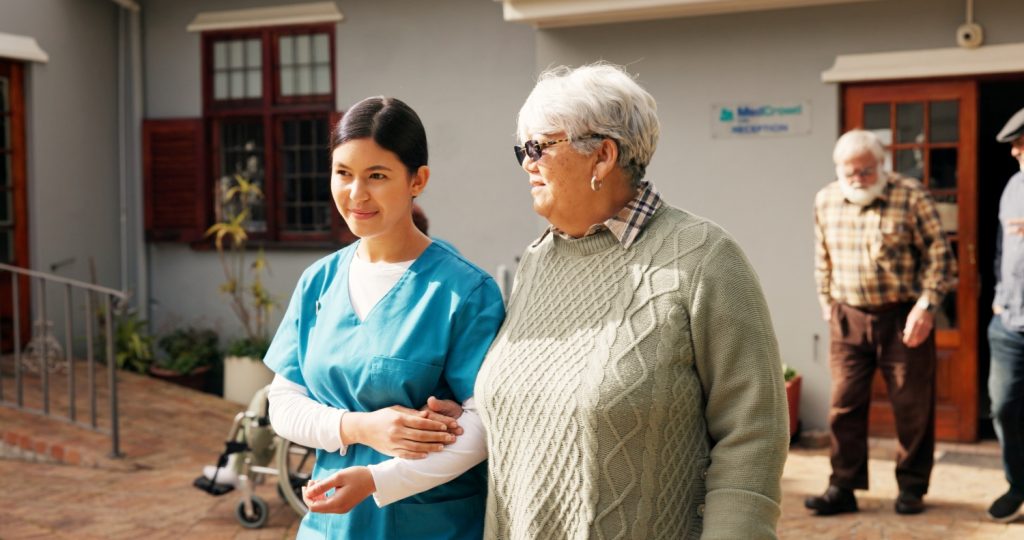Abstract
Trust for America’s Health (TFAH) is leading efforts to make healthy aging a core function of the public health sector. Through TFAH’s Age-Friendly Public Health Systems (AFPHS) movement, state, local, tribal, and territorial health departments are exploring and expanding their roles to improve the health of older adults, with a focus on health equity. By partnering and collaborating across the Age-Friendly Ecosystem, including with aging services providers, healthcare systems, community-based organizations, academia, policymakers, and many others, public health practitioners are developing innovative approaches to transform states and communities into places where older people can thrive.
Key Words
public health, healthy aging, age-friendly, equity, partnerships, collaboration
Trust for America’s Health’s (TFAH) Age-Friendly Public Health Systems (AFPHS) movement fosters transformational change in how health departments and public health organizations think about and address older adults’ health. With funding from The John A. Hartford Foundation, TFAH helps public health practitioners understand how they can prioritize older adult health and well-being as part of their core work through policy, systems, and programmatic changes. The public health sector is uniquely positioned to create and lead multi-sector efforts to build better data systems, enhance community planning, and better coordinate previously siloed efforts to support older adults and caregivers. Healthy aging requires that all sectors come together, aligning vision and scope to collectively support the health and well-being of all individuals across the life course.
Background
Older adult population growth in the United States is a public health success story, and this sector should be acknowledged for its significant contributions to increased longevity throughout the 20th century. However, older adults have not historically been prioritized for public health programs and services, largely due to a “lack of a systematic approach to addressing older adult health and well-being, lack of funding and resources, and limited capacity and expertise” (Wolfe & Gracia, 2023).
Public health departments and organizations exist in every U.S. state, county, and territory, and in the nation’s largest cities. They are uniquely situated to partner with organizations and lead efforts to develop programs and services for older adults, but face barriers to doing so. Key barriers for many public health departments and organizations are that they may not view their role as supporting healthy aging, they lack resources such as funding and staff capacity, or they are not certain how to expand their work to focus on older adult health.
The public health system “works to create the social and environmental conditions that address the needs of the whole population of older adults associated with housing, food availability, social engagement, transportation, and safety” (DeBiasi et al., 2020). Public health also can help administer community-based interventions to improve social determinants of health for older people (Ogden et al., 2012). Through new partnerships and collaboration with aging services providers and others, public health departments can coordinate their efforts and expand their capacity to reach older adults.
Developing the Framework for Age-Friendly Public Health Systems
In response to the growing recognition that the public health sector needed guidance to expand its roles in healthy aging, in 2017 TFAH hosted a convening of multi-sector partners to explore opportunities for engagement. The convening resulted in the creation of the Age-Friendly Public Health Systems 6Cs Framework, which delineates the roles public health can play to support and enhance older adult health and well-being. The tenets of the framework are:
- Creating and leading policy, systems, and environmental changes to improve older adult health and well-being.
- Connecting and convening multi-sector partners to address the health and social needs of older adults through collective impact approaches focused on the social determinants of health.
- Coordinating existing supports and services to help older adults, families, and caregivers navigate and access services and supports, avoid duplication, and promote an integrated system of care.
- Collecting, analyzing, and translating relevant and robust data on older adults to identify the needs and assets of a community and inform the development of interventions through community-wide assessment.
- Communicating important public health information to promote and support older adult health and well-being, including conducting and disseminating research findings and emerging and best practices to support healthy aging.
- Complementing existing health-promoting programs to ensure they are adequately meeting the needs of older adults.
At the center of this framework is the advancement of health equity. As noted by Sadana and colleagues (2016), health equity should be incorporated into all public health policies and programs. The AFPHS Framework provides a flexible approach for public health departments and organizations to develop age-friendly public health programs and policies, and to take steps toward aligning and expanding their work to ensure a life-course approach in the context of the Age-Friendly Ecosystem.
Public Health Roles: The Value of the 6Cs in the Age-Friendly Ecosystem
The AFPHS 6Cs Framework provides a useful context for age-friendly collaboration. The examples below demonstrate public health leadership in advancing state and community efforts to improve the lives of older adults and caregivers.
Creating and Leading Policy and Systems Change
A recent article in the Journal of Public Health Management and Practice (White et al., 2024) offered a detailed look into the development of Age-Friendly Mississippi, under the leadership of Dr. Kina White, director of the Office of Community Health Improvement. The Mississippi State Department of Health (MSDH) in 2023 began implementing AFPHS principles, following the adoption of an AFPHS 6Cs Statewide plan (Age-Friendly Public Health System for Mississippi, 2023).
‘Mississippi has become an exemplar in the creation of an age-friendly ecosystem.’
Dr. White’s dedication to this work was supported throughout the MSDH, including from its state health officer, demonstrating the value of leadership in creating systems change. This leadership led to the development of extensive partnerships and the expansion of programs and services focused on older Mississippians, including the development of the Healthy Aging Data Report (Mississippi State Department of Health, 2023) that provides key data on older adults for all 82 counties in the state.
Under Dr. White’s leadership, Mississippi has become an exemplar in the creation of an age-friendly ecosystem, demonstrated by collaborations with health systems, community-based organizations in the aging sector, universities focused on expanding educational opportunities for older people, and an expansion of dementia-friendly efforts. An article focused on the Mississippi age-friendly movement is included in this special issue (see “Advancing an Age-Friendly Ecosystem in Mississippi”).
Connecting and Convening Multi-Sector Partners
One of the public health sector’s well-established roles is connecting and convening partners and leaders from various sectors to focus on prevention and to improve myriad state and local government policies and practices. Applying a healthy aging lens to this role can help to break down silos and promote effective multi-sector action to address the complex health and social needs of older adults.
The Department of Health in Sarasota County, FL (DOH-Sarasota), is building genuine, strengths-based relationships with a diverse group of partners that reflect the community and population to address the needs of individuals living with Alzheimer’s disease and related dementias. As of this writing, 37% of Sarasota’s population is older than age 65, the highest percentage of any county in the state, and a higher rate than that in Florida’s overall older adult population (Florida Department of Health, 2023).
Data from the Sarasota community health assessment (Sarasota County, 2022) indicated that deaths from Alzheimer’s disease in 2020 in Sarasota County, FL, were also higher at 22%, than the state’s rate of 20.5%. And the rates of Alzheimer’s disease for Black and Hispanic individuals were higher than those of white and non-Hispanic populations.
Consequently, DOH-Sarasota identified brain health as a priority focus area. Recognizing the need for collaboration, the Department of Health initiated partnerships with the Sarasota Memorial Healthcare System, the Alzheimer’s Association Florida Gulf Coast Chapter, the Florida Department of Elder Affairs, the City of Sarasota, and others to develop and deliver public education tools about brain health and to foster practitioner education to support early diagnosis, care planning and referrals, and engagement with caregivers. The collaboration has resulted in the establishment of a Healthy Brain Roundtable, a Community Respite Program, and a Falls Prevention Program, and demonstrates how efforts can be sustained through multi-sector collaboration.
Coordinating Existing Supports and Services
The COVID-19 pandemic was a catalyst for many public health departments to create and enhance multi-sector partnerships. For some, relationships formed out of a need to quickly set up COVID-19 vaccination administration sites and to get vaccines into the community, particularly to those who could not leave their homes. In several Florida communities, county health departments had established partnerships with the aging services network through early piloting of the AFPHS framework. Existing partnerships between public health and aging services meant that communication channels already existed, which enhanced information sharing on where older adults lived and congregated, and enabled effective distribution of vaccines in these communities. Another example of the types of partnerships that occurred during the pandemic are community-based food-distribution coalitions that ensured all individuals were served, regardless of age.
Collecting, Analyzing, and Translating Data
California became the second state in the nation to be recognized under the AFPHS Recognition Program. The California Department of Health (CDH) has actively partnered with the California Department of Aging and all other state agencies in the development, implementation, and evolution of the California Master Plan on Aging (CA MPA). A crucial component of this work has been the creation of a data dashboard on older adult health, the Health Equity Index. The CA MPA was first released in 2021 and triggered the start of implementation, and is addressed in this issue (see “How Can Multisector Plans for Aging Advance Coordinated Care for Older Adults?”).
Since that time, MPA administrators recognized the need to quantify and track equity over time. The development of a new “Equity Index” began in 2023. The Equity Index focuses on four priority areas: older adult homelessness, psychological distress, caregiver burden, and the direct care workforce. The Index allows tracking by population and geographic variation and also can track potential drivers for each of these areas, enabling state agencies to assess equity across the MPA, and potentially identifying areas for each topic where inequity is greatest. This effort is an example of how collaboration across the age-friendly ecosystem can advance health equity for older adults.
Communicating Public Health Information
The role of public health in communications is paramount, and this tenet of the 6Cs Framework aligns with the 10 Essential Public Health Services framework that has guided public health efforts for more than 30 years (U.S. Centers for Disease Control & Prevention, 2024). Now, the public health sector must expand these communications to include healthy aging, not only for those most affected—older adults—but also to raise awareness of the public health roles in healthy aging, build partnerships, and advocate for a stronger and more sustainable public health infrastructure that supports healthy aging.
Healthy aging requires that all sectors come together, aligning vision and scope to collectively support the health and well-being of all individuals across the life course.
New York’s Orange County Department of Health (OCDOH) is working to adopt new programs to improve older adult health, including a plan to offer education programs for older adults to encourage healthy behaviors. To increase awareness about these programs, the OCDOH has identified community partners as trusted messengers, including local nonprofit organizations, public libraries, senior centers, and others. Recognizing the importance of such trusted messengers, OCDOH is at work formalizing these partnerships to galvanize engagement and leverage the advocacy and communication strengths of their partners.
Complementing Existing Supports and Services
No one sector or agency can address all issues and solve all challenges that older adults face across U.S. communities. But via multi-sector collaboration across the age-friendly ecosystem, funding and expertise can be leveraged and the duplication of services can be minimized. The Benton-Franklin Health District in Kennewick, WA, created a healthy aging webpage that houses information on brain health and memory care, caregiver resources, access to care (including for immigrant populations), and emergency preparedness (Benton-Franklin Health District, n.d.). It worked with the local area agency on aging to create and deliver emergency toolkits for older adults and provide a link to a resource for emergency planning for people living with dementia. This type of resource compilation can improve awareness of services and contact information and helps older adults and their families make better-informed decisions about their care.
Additional Opportunities for Public Health Leadership in the Age-Friendly Ecosystem
Multiple opportunities exist for public health leadership to enhance older adult health at all levels. Everyone is aging. Healthy aging can start at an early age when structural barriers to health and the silos that prevent multi-sector collaboration have been removed. As noted earlier, no single sector or agency has the resources or even the authority to achieve healthy aging alone. But working together, through collective impact or through other multi-sector strategies, policies and systems can be transformed to better support older adults, caregivers, and families.
Health Equity
The public health sector’s deep commitment to health equity can have a significant and lasting impact in the age-friendly ecosystem. The topic of cumulative disadvantage is covered in more depth in a companion article in this special issue (see “The Impact of Cumulative Inequities on Older Adult Health”). However, this concept—that socioeconomic disadvantages may accumulate over one’s life course and result in complex health conditions in later life—is important to mention in the context of public health leadership. Although no one sector can address structural discrimination on its own, public health leaders can bring expertise in addressing social and structural determinants of health into collaborative opportunities to work across sectors to improve health equity for older adults.
Multisector Plans for Aging
Another opportunity for public health sector leadership is in the development of multisector plans for aging (MPAs), underway in more than half of U.S. states. A more in-depth discussion of MPAs is the focus of another article in this special issue (see “How Can Multi-sector Plans for Aging Advance Coordinated Care for Older Adults?”). The significance of state MPAs lies in the approval required from the state governor’s office, which reflects support at the highest level. This buy-in is crucial to ensure there is a commitment to developing the plan and accountability for completing it. Because MPAs typically reflect policy and systems change, public health engagement is crucial, and public health professionals can bring a population health perspective to the systems change conversation.
Community Health Improvement Planning
Another significant area for public health leadership in the context of the age-friendly ecosystem is in the community health improvement planning process. Community health assessments (CHA) and community health improvement plans (CHIPs) are required in all local health departments in the United States. This is an opportunity to assess the needs of a community, from individual and jurisdiction-wide perspectives.
According to the National Association of County and City Health Officials, “a community health improvement process uses data to identify priority issues, develop and implement strategies for action, and establish accountability to ensure measurable health improvement, which are often outlined in the form of a community health improvement plan. A community health improvement process looks outside of the performance of an individual organization serving a specific segment of a community to the way in which the activities of many organizations contribute to community health improvement” (Durch et al., 1997).
A crucial aspect and first step of the CHA process is to organize and engage partners, as well as the people most affected by the adopted policies and plans, such as older people and caregivers. Many CHA coalitions reflect sectors of the age-friendly ecosystem, including public health, healthcare systems, community-based organizations, academia, businesses, and individuals. However, not many CHIPs include older adult health priorities, but as more public health practitioners commit to healthy aging work, these assessment and planning processes can become age-friendly ecosystem collaborative partnerships.
Conclusion
Healthy aging requires that all sectors join through an aligned vision and scope to collectively support the health and well-being of all people across the life course. The public health sector can play crucial roles to ensure that policies and systems are in place to optimize physical, mental, and social well-being, and that equity is embedded across these systems. Collective and aligned improvements across multiple sectors will improve the lives of older adults, their families, and their caregivers; reduce healthcare costs and improve health outcomes; and help to create healthy, resilient, and thriving communities and a healthy and thriving nation. Aligning efforts and sectors through the Age-Friendly Ecosystem can achieve these goals.
J. Nadine Gracia, MD, MSCE, is president and CEO, Karon Phillips, PhD, MPH, CHES, is policy development manager, and Megan Wolfe, JD, is senior policy development manager, at all Trust for America’s Health in Washington, DC.
Photo credit: Shutterstock/People Images – Yuri A
References
Age-Friendly Public Health System for Mississippi. (2023). Statewide work plan January 2023. State of Mississippi. https://www.mspha.org/wp-content/uploads/2024/02/AFPHSMississippiRevisedWorkPlan_2023-Final.pdf
Benton-Franklin Health District. (n.d.) Healthy aging. State of Washington. https://www.bfhd.wa.gov/cms/one.aspx?portalId=10766056&pageId=18473402
De Biasi, A., Wolfe, M., Carmody, J., Fulmer, T., & Auerbach, J. (2020). Creating an age-friendly public health system. Innovation in Aging, 4(1), igz044-. https://doi.org/10.1093/geroni/igz044
Durch J. S., Bailey L. A., & Stoto, M. A. (1997). Improving health in the community: A role for performance monitoring. National Academies Press. https://pubmed.ncbi.nlm.nih.gov/25121202/
Florida Department of Health. (2023). Aging in Florida dashboard. State of Florida. https://www.flhealthcharts.gov/ChartsDashboards/rdPage.aspx?rdReport=AgingInFlorida.Overview&tabid=Overview&islCounty=58
Mississippi State Department of Health. (2023). Healthy aging reports and data. State of Mississippi. https://msdh.ms.gov/page/43,0,430,740.html
Ogden, L. L., Richards, C. L., & Shenson, D. (2012). Clinical preventive services for older adults: The interface between personal health care and public health services. American Journal of Public Health, 102, 419-425. https://doi.org/10.2105/AJPH.2011.300353
Sadana, R., Blas, E., Budhwani, S., Koller, T., & Paraje, G. (2016). Healthy ageing: Raising awareness of inequalities, determinants, and what could be done to improve health equity. Gerontologist, Supplement(2), S178-S193. https://doi.org/10.1093/geront/gnw034
Sarasota County. (2022). Community Health Improvement Plan October 2020-September 2025. Sarasota_CHIP1.pdf
U.S. Centers for Disease Control & Prevention. (2024). 10 Essential Public Health Services. https://www.cdc.gov/environmental-health-services/php/10-essential-services/?CDC_AAref_Val=https://www.cdc.gov/nceh/ehs/10-essential-services/index.html
White, K., Wolfe, M., Kunkel, S., Carmody, J., & Auerbach, J. (May/June 2024). How Mississippi is changing public health. Journal of Public Health Management and Practice, 30(3), 321-324. https://doi.org/10.1097/PHH.0000000000001920
Wolfe, M., & Gracia, J. N. (2023). The value of age-friendly public health systems in the age-friendly ecosystem. Geriatrics (Basel), 8(3), 63. https://doi.org/10.3390/geriatrics8030063













